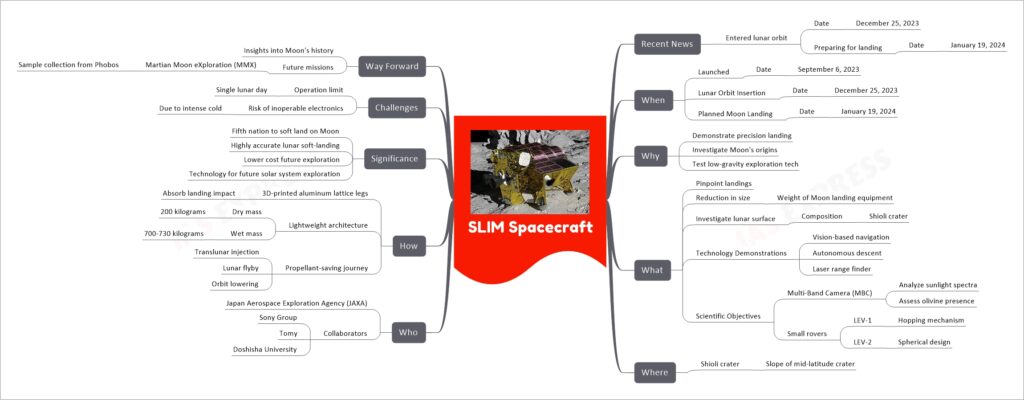SLIM Spacecraft: Japan’s Lunar Explorer
Summary
The SLIM Spacecraft, developed by Japan’s Aerospace Exploration Agency (JAXA), represents a significant step in lunar exploration. Launched in September 2023, SLIM’s primary goal is to achieve a highly accurate, pinpoint landing on the Moon’s surface, specifically targeting the Shioli crater. This innovative mission utilizes advanced technologies, such as vision-based navigation and lightweight architecture, to demonstrate precise lunar landing capabilities. With its successful landing, SLIM aims to set new standards in lunar exploration, potentially enabling more focused scientific investigations of specific lunar sites. The mission also aims to test technologies fundamental for future exploration within the solar system. The SLIM mission’s success could pave the way for more cost-effective and precise lunar missions, contributing significantly to our understanding of the Moon and beyond.
Article
In the realm of space exploration, the SLIM spacecraft has emerged as a remarkable project undertaken by the Japan Aerospace Exploration Agency (JAXA). This article delves into the intricacies of SLIM, its objectives, and significance.
When and Why SLIM Launched
- Launched Date: September 6, 2023
- Lunar Orbit Insertion Date: December 25, 2023
- Planned Moon Landing Date: January 19, 2024
SLIM’s mission is driven by a triad of objectives:
- Demonstrate Precision Landing: SLIM aims to showcase its ability to perform pinpoint landings on the lunar surface.
- Investigate Moon’s Origins: It seeks to uncover the mysteries surrounding the Moon’s origins, contributing to our understanding of the solar system’s history.
- Test Low-Gravity Exploration Tech: By testing cutting-edge low-gravity exploration technologies, SLIM paves the way for future lunar exploration missions.
What SLIM Does
SLIM’s capabilities are extensive and include:
- Pinpoint Landings: SLIM is engineered for pinpoint landings on the Moon’s surface, ensuring highly accurate touch-downs.
- Reduction in Size: It boasts a significant reduction in the size and weight of lunar landing equipment, making it more efficient and cost-effective.
- Investigate Lunar Surface: SLIM will analyze the lunar surface, with a particular focus on the composition of the Shioli crater, a mid-latitude crater.
- Technology Demonstrations: It showcases pioneering technology such as vision-based navigation, autonomous descent, and a laser range finder.
- Scientific Objectives: SLIM carries a Multi-Band Camera (MBC) to analyze sunlight spectra and assess the presence of olivine. Additionally, it deploys small rovers – LEV-1 with a hopping mechanism and LEV-2 with a spherical design – to conduct surface investigations.
Where and Who Is Involved
SLIM’s mission destination is the Shioli crater, located on the slope of a mid-latitude lunar crater. The project is spearheaded by the Japan Aerospace Exploration Agency (JAXA) and collaborates with notable entities such as the Sony Group, Tomy, and Doshisha University.
How SLIM Works
The spacecraft is equipped with several innovative features, including:
- 3D-Printed Aluminum Lattice Legs: These legs are designed to absorb the landing impact, ensuring a soft and precise touchdown.
- Lightweight Architecture: SLIM has a dry mass of 200 kilograms and a wet mass ranging from 700 to 730 kilograms, emphasizing its lightweight and efficient design.
- Propellant-Saving Journey: SLIM’s journey involves key phases, including translunar injection, lunar flyby, and orbit lowering, all designed to maximize propellant efficiency.
Significance and Challenges
The mission holds immense significance for space exploration, marking several milestones:
- Fifth Nation to Soft Land on Moon: If successful, Japan will join a select group of nations that have achieved a soft landing on the Moon.
- Highly Accurate Lunar Soft-Landing: SLIM’s precision landing technology is a valuable asset for future lunar exploration missions.
- Lower Cost Future Exploration: The reduction in equipment size and weight contributes to cost-effective space exploration.
- Technology for Future Solar System Exploration: SLIM’s innovations can be adapted for future missions beyond the Moon.
However, the mission is not without its challenges, including operating within a single lunar day and the risk of electronics becoming inoperable due to extreme cold conditions.
Way Forward
As SLIM continues its mission, it promises to provide insights into the Moon’s history. Additionally, its success will pave the way for future exploration missions, including the Martian Moon eXploration (MMX) project, which aims to collect samples from Phobos, one of Mars’ moons.
If you like this post, please share your feedback in the comments section below so that we will upload more posts like this.


